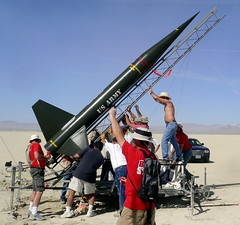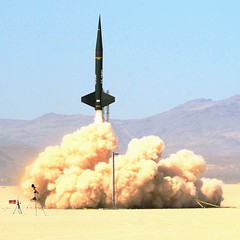As the sun sets on a wonderful set of insect photos from the Wild...
I thought I should start with a transition photo, on a photosynthetic bug bed, to a new photo theme - rockets:
Many insects have served as brave cosmonauts - flying as a somewhat unwilling payload in Estes rockets. The National Association of Rocketry has rules against living payloads, but they make an exception for invertebrates. (I think the intent of the rule was to prevent kids from flying their sister's pet, but to allow for some curious exploration.)
The Quark is the smallest rocket I have built, with rear-swept fins to avoid nose weight and light enough to tumble back without parachute. It takes half-A-size motors.
If you have participated in some of the 500 million Estes rocket launches that have taken place over the years, you may recall that each letter grade of a motor is a rough doubling of total impulse (B is 2xA, C is 2xB and so on).
So, on the other end of the spectrum, the home brew Q-motor in Wedge's Nike is about 2^17 larger than the Quark ½-A motor. That's over 100,000 Quarks going at once. 4x the impulse of a cruise missile booster. It's a powerful subwoofer roar to witness... as 437 lbs roars off the pad going supersonic:


So blog topics can include extreme rocket launches, on-board video, night launches, tips on photographing supersonic shreds overhead, how to get started, and the joy of rocket science. What would interest you?


I'd love to see various kinds of payloads that you've worked with - whether they're living or not. I recall one with an egg when I was a Cub Scout, but surely in the decade since then the rocketry community has come up with more exciting things to launch.
I've some questions on logistics and requirements. Obviously, that last Nike example has potential "Scud" capabilities, so what are the restrictions here? When do the models we played with as a kid become of interest/concern to Big Bro? Are there limitations to the tech you are allowed to put in one? There is an altitude restriction also, if I remember right. Is this clear cut or a gray area?
Sorry for the list of questions, but am curious...
Whoa that's a really amazing sunset shot.
This may sound boring and kind of wonky, but I'd like to hear a bit about the legal aspects of rocketry. Surely there aren't too many jurisdictions that will let you just saunter in and launch a 400 pound rocket.
On a more practical level, what if I just want to make a little starter rocket to launch from the driveway? In your experience, do municipalities tend to have regulations about those things? Who do you ask?
Wow. I can't think of a better illustration of the famous "and now for something completely different."
Let's get some basics in here too. What fuels do these different motors use? And maybe a list of links to useful model rocketry web sites.
chezjake - I had exactly that Monty Python quote in there, but then edited around it...
Great suggestions. There are several layers of legal restrictions from NOTAMs to the FAA to recently revoked restrictions by the ATF and effective self-regulation by the hobbyists themselves. Good topic for an early post. Most neighborhoods do NOT want rockets, and for my town I had to check the municipal code for my town (which clearly said no torpedos, but was mum on rockets). The best starting point is the local clubs. I should collect some links to the NAR and Tripoli prefectures (for the U.S.)... I get the sense this is harder to do in other countries. And in the U.S., the big stuff works easiest in Nevada. =)
Most neighbourhoods do not want rockets
What's wrong with these people?
OK, I want to see pictures of rockets under construction, and I'd also like to see the process of building the custom motors. Any funny pictures of rocket bloopers would be great as well :D
Most neighborhoods do NOT want rockets, and for my town I had to check the municipal code for my town (which clearly said no torpedos, but was mum on rockets)